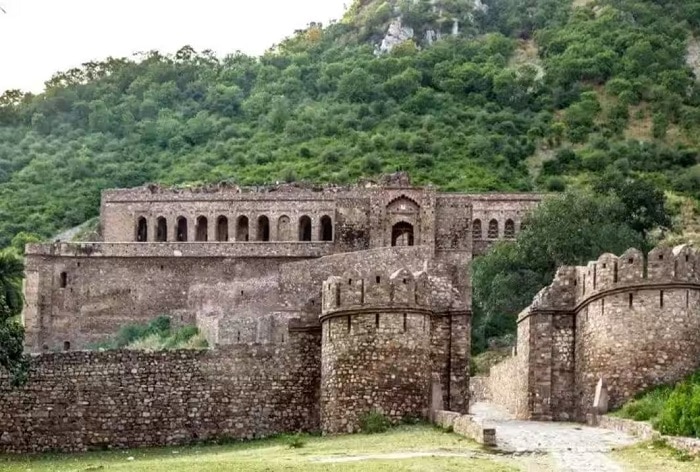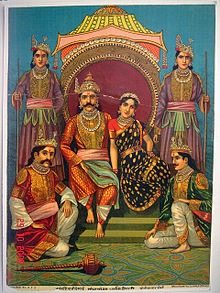S
Shruti Dasgupta
Guest
Every year on the 15th of August the Prime Minister of India hoists the flag of India from Red Fort or Lal Qila. The unfurled tricolor is a symbol of the rising India. This flag shows the world the power of a united India. The immaculate fort structure showcases the long history of Bharat. However, there are many questions about the red fort’s true origins. A short sojourn in the lanes of history is a must to rethink the narrative of red fort’s true legacy.

PC india.com
For generations, the Red Fort, or Lal Qila, has stood as an iconic symbol of India’s rich history. Yet, beneath the familiar narrative that presents it as a grand gift from the Mughals, there lies a fascinating tale that often remains untold. Recent insights have unveiled a lesser-known truth about this majestic fort. The hidden truth of the Qila challenges the conventional and propagated belief of its origins.
The widely held notion is that the Lal Qila was solely the creation of the Mughals. Contrarily, historical records trace the beginnings of the Fort to a much earlier period in memoirs of India. The Red Fort’s story began long before the Mughals ever became rulers of small regions of the Indian subcontinent.
The Red Fort’s journey commenced in the year 1060 A.D., marking the establishment of what is recognized as Delhi’s inaugural city. The architects of this remarkable citadel were not the Mughal emperors, but rather the Tomar dynasty. Raja Anang Pal, a visionary ruler from the Tomar lineage and a forefather of Prithviraj Chuahan, chose the barren yet strategic hills to the south of present-day New Delhi as the site for this fortified city.
Lal Kot is an earlier iteration of the Red Fort. It was named after its founder as “Qila Rai Pithora”. This structure offers a captivating glimpse into the past. It housed a burgeoning populace estimated to be around 5,000 to 6,000 inhabitants across an expanse of approximately 3.40 square kilometers.

PC The Wire
The fascinating narrative continues as the historical walls of the Lal Qila reveal remnants of its earlier form. One notable artifact is the Iron Pillar or Kirti Stambh. It is a towering structure of 7.2 meters in height. The Kirti Stambh’s origins also trace back further than any Muslim invader of India. It stands tall as a testament to the fort’s enduring legacy.
A theory of its origin is that Raja Anang Pal might have brought this pillar to Delhi. Another theory claims that this pillar was placed by Raja Dhruva in the 4th century A.D. Today this scientific marvel graces the vicinity of the renowned Qutub Minar within the Mehrauli Archaeological Park. The pillar stands as a symbol of the metallurgical competence of early Indians. To date, the world is astounded by this pillar that does not rust or decompose. Scientists are still struggling to unravel its secrets.

PC Our Heritage @ vikramjits.wordpress.com
An old tradition traces the origins of Dhilli or Dilli to Raja Dhilu or Dillu. This potentially marks its foundation at the outset of the first millennium A.D. However, a more widely accepted theory places the birth of the initial city around the mid-8th century A.D. This event is attributed to the Tomar Rajputs, who named the settlement Dilli, Dhilli, or Dhillika. This particular theory gains prominence as it aligns with historical and archaeological evidence of the Tomar dynasty’s influence in the region during that period.

PC Hindustan Times
In 2007, the Red Fort cecame a UNESCO World Heritage Site. However, a somber reality accompanies this recognition. Currently, only 20% of the original Red Fort Complex is accessible to visitors and history buffs. The British transformed significant portions of the fort into their military camp during their rule of India. This unfortunate turn of events altered the landscape of this grand edifice. However, while the transformation diminished its glory, the significance of the Lal Qila in the hearts of ‘Dilliwale’ remains.
While the Red Fort’s Tomar origins are slowly being recognized and accepted, it is crucial to question the prevailing narrative that attributes its creation solely to the Mughals. This narrative oversimplifies the complex history of India. It also showcases how certain ‘ditortians’ placed undue credit on the invaders or enslavers of India. Their attempt to overshadow or downplay the endeavors of the Tomar dynasty in shaping the foundations of Lal Qila’s architectural marvel is obvious to modern Indians.
A correction to the narrative that enshrouds the Lal Qila is essential in the times of today. A more nuanced and comprehensive story of the fort should be spread to ensure that each Indian recognizes their true roots. The emerging true narratives help all Indians regain pride in the nation. It also helps Indians appreciate monument that were built by the sweat and blood of their forefathers millennia ago. The ingenuity and vision of the Tomar dynasty is usually ignored by ‘distortians’. Their contribution to what would eventually become one of India’s most iconic landmarks should be given its due cognizance. While the Mughal influence on Lal Qila is undeniable, acknowledging the fort’s Tomar origins is also essential to celebrate the diverse threads that weave the tapestry of India’s history.
References
The post Rethinking the Narrative: The Red Fort’s True Origins appeared first on The Jaipur Dialogues.
Continue reading...
Unveiling the Tomar Legacy and the Unexpected Origin of Lal Qila

PC india.com
For generations, the Red Fort, or Lal Qila, has stood as an iconic symbol of India’s rich history. Yet, beneath the familiar narrative that presents it as a grand gift from the Mughals, there lies a fascinating tale that often remains untold. Recent insights have unveiled a lesser-known truth about this majestic fort. The hidden truth of the Qila challenges the conventional and propagated belief of its origins.
The widely held notion is that the Lal Qila was solely the creation of the Mughals. Contrarily, historical records trace the beginnings of the Fort to a much earlier period in memoirs of India. The Red Fort’s story began long before the Mughals ever became rulers of small regions of the Indian subcontinent.
The Red Fort’s journey commenced in the year 1060 A.D., marking the establishment of what is recognized as Delhi’s inaugural city. The architects of this remarkable citadel were not the Mughal emperors, but rather the Tomar dynasty. Raja Anang Pal, a visionary ruler from the Tomar lineage and a forefather of Prithviraj Chuahan, chose the barren yet strategic hills to the south of present-day New Delhi as the site for this fortified city.
A Glimpse into the Past of Qila Rai Pithora and Kirti Stambh
Lal Kot is an earlier iteration of the Red Fort. It was named after its founder as “Qila Rai Pithora”. This structure offers a captivating glimpse into the past. It housed a burgeoning populace estimated to be around 5,000 to 6,000 inhabitants across an expanse of approximately 3.40 square kilometers.
Temples, pillars, and tanks dotted its landscape, hinting at a vibrant life that once thrived within its walls. To date, the remnant structures of Quila Rai Pithora highlight the fort’s grandiose history.

PC The Wire
The fascinating narrative continues as the historical walls of the Lal Qila reveal remnants of its earlier form. One notable artifact is the Iron Pillar or Kirti Stambh. It is a towering structure of 7.2 meters in height. The Kirti Stambh’s origins also trace back further than any Muslim invader of India. It stands tall as a testament to the fort’s enduring legacy.
A theory of its origin is that Raja Anang Pal might have brought this pillar to Delhi. Another theory claims that this pillar was placed by Raja Dhruva in the 4th century A.D. Today this scientific marvel graces the vicinity of the renowned Qutub Minar within the Mehrauli Archaeological Park. The pillar stands as a symbol of the metallurgical competence of early Indians. To date, the world is astounded by this pillar that does not rust or decompose. Scientists are still struggling to unravel its secrets.
Tomars’ ‘Dilli’ to the British Delhi

PC Our Heritage @ vikramjits.wordpress.com
An old tradition traces the origins of Dhilli or Dilli to Raja Dhilu or Dillu. This potentially marks its foundation at the outset of the first millennium A.D. However, a more widely accepted theory places the birth of the initial city around the mid-8th century A.D. This event is attributed to the Tomar Rajputs, who named the settlement Dilli, Dhilli, or Dhillika. This particular theory gains prominence as it aligns with historical and archaeological evidence of the Tomar dynasty’s influence in the region during that period.

PC Hindustan Times
In 2007, the Red Fort cecame a UNESCO World Heritage Site. However, a somber reality accompanies this recognition. Currently, only 20% of the original Red Fort Complex is accessible to visitors and history buffs. The British transformed significant portions of the fort into their military camp during their rule of India. This unfortunate turn of events altered the landscape of this grand edifice. However, while the transformation diminished its glory, the significance of the Lal Qila in the hearts of ‘Dilliwale’ remains.
Conclusion
While the Red Fort’s Tomar origins are slowly being recognized and accepted, it is crucial to question the prevailing narrative that attributes its creation solely to the Mughals. This narrative oversimplifies the complex history of India. It also showcases how certain ‘ditortians’ placed undue credit on the invaders or enslavers of India. Their attempt to overshadow or downplay the endeavors of the Tomar dynasty in shaping the foundations of Lal Qila’s architectural marvel is obvious to modern Indians.
A correction to the narrative that enshrouds the Lal Qila is essential in the times of today. A more nuanced and comprehensive story of the fort should be spread to ensure that each Indian recognizes their true roots. The emerging true narratives help all Indians regain pride in the nation. It also helps Indians appreciate monument that were built by the sweat and blood of their forefathers millennia ago. The ingenuity and vision of the Tomar dynasty is usually ignored by ‘distortians’. Their contribution to what would eventually become one of India’s most iconic landmarks should be given its due cognizance. While the Mughal influence on Lal Qila is undeniable, acknowledging the fort’s Tomar origins is also essential to celebrate the diverse threads that weave the tapestry of India’s history.
References
- https://webthesis.biblio.polito.it/10717/1/tesi.pdf
- https://www.nios.ac.in/media/documents/SecICHCour/English/CH.13.pdf
- https://online.dda.org.in/mpd2041dda/_layouts/MPD2041FINALSUGGESTION/Vol%204.pdf
- https://epgp.inflibnet.ac.in/epgpdata/uploads/epgp_content/S000829IC/P001803/M027464/ET/1519191171P14-M20-Pre-MughalPaintingTraditionsinIndia-ET.pdf
The post Rethinking the Narrative: The Red Fort’s True Origins appeared first on The Jaipur Dialogues.
Continue reading...
